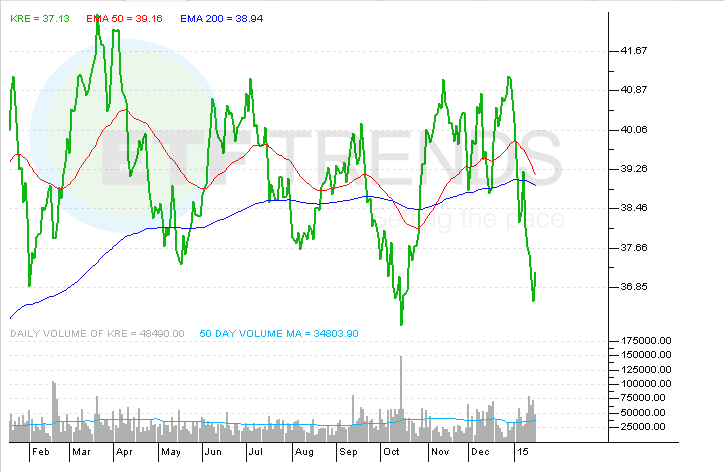Regional Bank ETFs Still Scuffling
Victimized by last year’s epic decline by 10-year Treasury yields, regional bank exchange traded funds staggered to mediocre annual returns. For example, the SPDR S&P Regional Banking ETF (KRE) , the largest regional bank ETF, returned just 1.8% last year, a meager showing compared to the 15.1% returned by the Financial Select Sector SPDR (XLF) .
With the broader financial services sector struggling to start 2015, KRE and rival regional bank ETFs are feeling the heat. KRE is lower by 9.7%, again well behind the 5.5% shed by XLF.
Earlier Tuesday, Regions Financial (RF), which has a weight of 1.33% in the equal-weight KRE, “reported a surprising miss on fourth-quarter earnings of 14 cents a share, below consensus of 21 cents a share. Some of that could be attributed to legal accruals and a charge for closing 50 branches a year, but loan growth seems to have been decent, fee income weaker, and there was higher expenses, and a lower tax rate,” according to CNBC.
As is usually the case with regional banks and the corresponding ETFs, interest rates remain a sticking point.
“We continue to believe the primary risk for regional banks is lower long-term rates while the Fed is raising short rates. In this scenario, we believe short-duration, asset-sensitive banks have more upside as well as less downside estimate risk if rates do not rise, as we believe the longer-duration balance sheet banks will likely experience greater reinvestment risk,” said Guggenheim Securities in a note posted by Barron’s earlier this month.
Guggenheim likes “asset sensitive” regionals, including Comerica (CMA), KeyCorp (KEY), Fifth Third Bancorp (FITB), Citizens Financial (CFG) and Sterling Bancorp (STL). KeyCorp and Fifth Third combine for 2.7% of KRE’s weight.
However, some of those banks have exposure to energy loans. For example, 8% of Zions’ (ZION) loan portfolio goes to the energy sector. For Regions, it is 3.5%. Zions is 1.35% of KRE’s weight.
Still, an improving U.S. economy could foster increased borrowing and financing by businesses, large and small, across the U.S. while benign mortgage rates could also provide a lift to the mortgage lending operations of regional banks. ETFs such as KRE benefit as rates rise because investors believe higher interest rates will lead to increased net interest margins for regional banks. [Rising Rates Plays Rise Again]
SPDR S&P Regional Banking ETF

